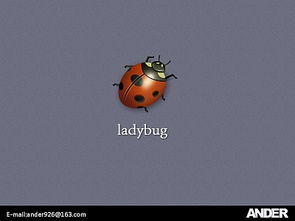
Lady Bug Bites: A Comprehensive Guide
Have you ever had the misfortune of encountering ladybug bites? These tiny, red insects might seem harmless, but their bites can cause quite a stir. In this article, we will delve into the details of ladybug bites, exploring their causes, symptoms, treatment, and prevention methods. So, let’s get started on this bug bite adventure!
What Are Ladybug Bites?

Ladybug bites occur when a ladybug, also known as a ladybird, feels threatened or is disturbed. These insects have a defense mechanism that involves releasing a substance called hemolymph, which can cause irritation and redness on the skin. While ladybug bites are generally not harmful, they can be quite uncomfortable.
Causes of Ladybug Bites

Ladybugs are most active during the spring and fall seasons. They can be found in various environments, including gardens, forests, and even inside homes. Here are some common causes of ladybug bites:
-
Disturbing a ladybug while it is resting or feeding
-
Handling a ladybug without proper precautions
-
Encountering a large number of ladybugs in a confined space
Symptoms of Ladybug Bites

Ladybug bites typically cause the following symptoms:
-
Red, itchy bumps on the skin
-
Pain or a stinging sensation at the bite site
-
Inflammation and swelling around the bite
-
In rare cases, hives or an allergic reaction
It’s important to note that the severity of symptoms can vary from person to person. Some individuals may experience mild irritation, while others may have more severe reactions.
Treatment for Ladybug Bites
Most ladybug bites can be treated at home with the following remedies:
-
Cool Compress: Apply a cool, wet compress to the bite area to reduce swelling and soothe the skin.
-
Antihistamines: Over-the-counter antihistamines can help alleviate itching and reduce inflammation.
-
Hydrocortisone Cream: Apply a small amount of hydrocortisone cream to the bite to reduce swelling and itching.
-
Avoid Scratching: Scratching the bite can worsen the symptoms and increase the risk of infection.
In some cases, if the symptoms are severe or do not improve within a few days, it’s best to consult a healthcare professional.
Preventing Ladybug Bites
Here are some tips to help prevent ladybug bites:
-
Be cautious when handling ladybugs, especially if you have sensitive skin.
-
Keep your living space clean and free of clutter to reduce the number of ladybugs that may enter your home.
-
Use screens on windows and doors to prevent ladybugs from entering your home.
-
Remove ladybugs from your home using a vacuum cleaner or by gently sweeping them outside.
Conclusion
Ladybug bites can be an unpleasant experience, but they are generally not harmful. By understanding the causes, symptoms, treatment, and prevention methods, you can minimize your risk of encountering ladybug bites. Remember to be cautious when handling these tiny insects and seek medical attention if you experience severe symptoms.
| Symptoms | Description |
|---|---|
| Red, itchy bumps | Typical reaction to ladybug bites, caused by the release of hemolymph. |
| Pain or stinging sensation | Immediate reaction at the bite site, usually mild. |
| Inflammation and swelling | May occur around the bite area, contributing to discomfort. |
Hives or allergic reaction
Related Postsfrench onion soup bites,French Onion Soup Bites: A Culinary Delight for Your Taste BudsFrench Onion Soup Bites: A Cul… bit lip sore,Understanding Bit Lip Sore: A Comprehensive GuideUnderstanding Bit Lip Sore: A … Like |



